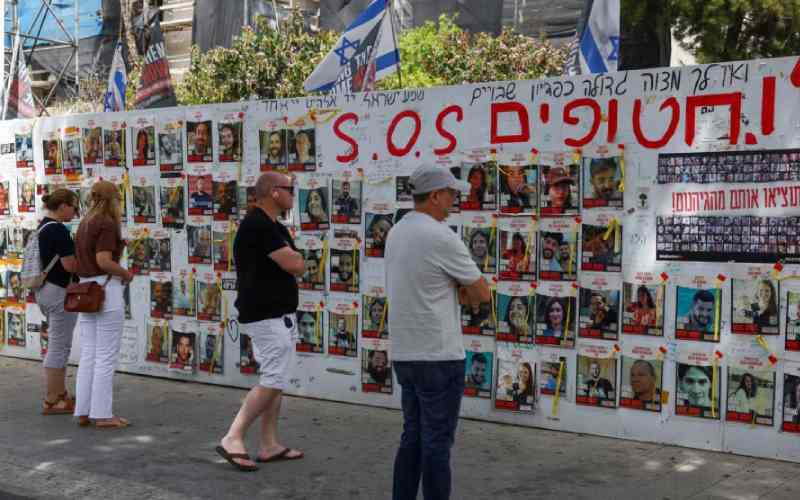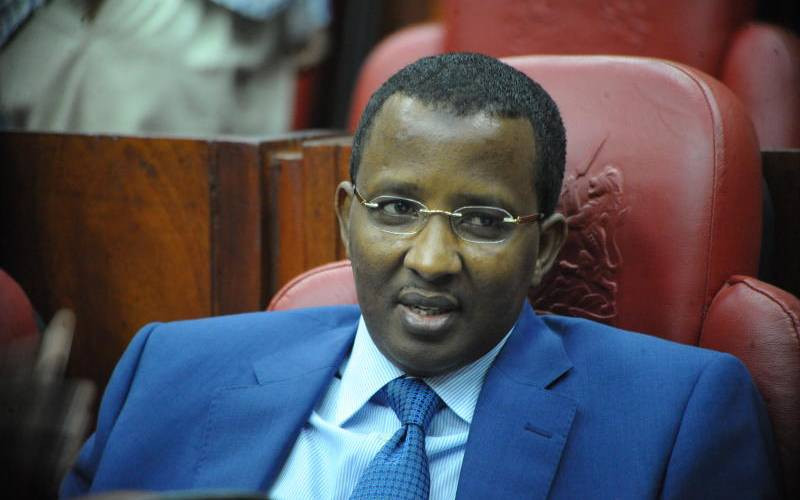 |
|
A police officer pulls down the Al Shaabab flag from Musa Mosque. |
By ISHAQ JUMBE
The storming of Masjid Musa Mosque in Mombasa last Sunday has precedents in similar assaults in India in 1984, Texas in 1993 and Pakistan in 2007.
Some Kenyan Muslims have described the Sunday storming as a desecration of a holy shrine. The Sunday incident followed hot on the heels of the publication of a report discussing the role played by British agents in the June 3-8, 1984 storming of the Sikh Holy Temple at Amritsar in India and criminal trial of former Pakistan President Pervez Musharraf over the so-called Operation Sunrise of July 2007 in Islamabad.
“What the police did today at Masjid Musa was nothing short of an act of terrorism,” said Mvita MP Abdulswamad Nassir following the raid.
In an equally controversial Facebook posting, the first-time MP argued against the storming of the mosque by police, claiming the officers should have devised a better way of handling the situation.
Security officials and Muslim leaders remain divided over how police should have handled the matter. Whereas police look at this matter as a purely security operation intended to end a criminal siege, Muslim leaders and activists maintain that the law enforcers should have waited for the alleged armed men to come out of the mosque or address the root causes of the youth grievances.
Divided opinion
The back and forth on what is the greater evil between storming a mosque in shoes or entering the holy place carrying weapons reflects the divided opinion between faithful and secularists when it comes to combating militant or sectarian groups.
Meanwhile, there is wide disagreement over who shot first or what prompted the assault, how many people were killed on both sides or whether the real leaders of the militants were captured.
Similar debates are yet to be resolved over similar conflicts in Amritsar, India, Texas in the USA and the storming of the Lal Masjid or Red Mosque in Pakistan.
Operation Blue Star was launched on the Sikh Holy Temple at Amritsar in Punjab on the orders of former Prime Minister Indira Gandhi by India’s military to capture Jarnail Singh Bindranwale, the leader of a Sikh sect Akali Dali that was agitating for the secession of Sikh-dominated areas of India to form the so-called Khalistan (Land of the pure).
The assault followed unheeded orders by the Gandhi regime to leave the temple.
Some 83 soldiers were killed, with 220 sustaining injuries in the temple, according to official records that indicated 500 civilian deaths.
Another notable mosque storming was the assault on Lal Masjid or Red Mosque in Pakistan on July 11, 2007, which resulted in the death of 154 people and the capture of 50 militants following an eight-day siege.
Two brothers — Maulana Abdul Aziz and Abdul Rashid Ghazi — who supported the imposition of Sharia law in Pakistan and openly called for the overthrow of the Pakistani Government orchestrated the siege at seminaries operated by them in Islamabad. They had opposed Musharraf’s war against the Taliban, advocated imposition of Islamic law or Sharia and overthrow of Musharraf’s government.
Stay informed. Subscribe to our newsletter
The Ghazi brothers died in the assault and officials claim to have seized heavy weapons and letters linking them to Al Qaeda. Similar claims have also been made in the Masjid Musa raid.
Reports have shown that Operation Sunrise succeeded in part due to the use of surveillance drones supplied by the US over the seminaries.
The so-called Waco siege on a fanatical offshoot of a Seventh Day Adventist began on February 28, 1993 at a remote farm in Waco, Texas and ended in a bloodbath on April 19 of the same year, a bloodbath in which David Koresh, the demented charismatic leader of the so-called Branch Davidians, was killed alongside sect members and federal agents.
In total, 76 sect members, including nine children, were killed in fire and gun violence.
Koresh’s doomsday cult apparently prepared its members for the end of the world, forcing them to engage in days of prayers and penitence. Defectors alerted federal agents about the stockpiling of assault weapons and sexual abuse, prompting agents to obtain a search warrant.
The Davidians resisted with gunfire at the first search, leading to the deaths of four agents and six sect members. After 51 days of negotiations, federal agents stormed the compound with gunfire and teargas. A fire erupted during the fight. It has never been known who started the fire or shooting, although the US government authorities say the sect members did on Koresh’s orders.
According to Catholic priest Father Gabriel Dolan, there are many common denominators in the three events and the Musa Mosque.
Nonetheless, the Musa assault remains hazy in some aspects.
He says the first three events were orchestrated by charismatic leaders with a negative stranglehold on their sectarian followers and that the followers were motivated either by political or messianic messages or some kind of liberation theology which cannot be repressed by force.
The priest suggests that the militant youth at Musa belong to a sect within mainstream Islam like the Ghazi brothers, Akali Dali followers and Branch Davidians did.
He also believes militants at Musa are a very tiny sect, but says that unlike the Waco Siege or the one at Amristsar and Islamabad, the radicals at Musa “seemed not to have a clear leader, or their leader is not known or might not have been in the mosque during the raid”.
Fr. Dolan says the secrecy with which the sect at Masjid Musa appears to operate makes it difficult to investigate its leadership, but adds that in all these cases, including Musa, the militants involved appear to harbour a sense of grievance against society believing in a violent transformation of the same along their sectarian point of view.
Modus operandi
Security officials in Mombasa believe the militants in Masjid Musa appear to follow the same modus operandi as the Davidians, Ghazi brothers and Sikh militants.
“What was happening here is pure radicalisation and incitement. There is no worship taking place there,” says Mombasa County police commander Robert Kitur, justifying the assault that he insists was launched after the militants fired first at officers.
“These people were prepared to fight,” adds Henry Ondiek, the Coast region’s CID officer.
Officially, Kitur and Ondiek have not disclosed the leader behind the Musa convention, although Intelligence sources have suggested that a Mr Besha Abdulwahab, an Al Qaeda trained militant, was behind the meeting that apparently received funding from some businessmen in Mombasa.
Apparently, Besha escaped after capture or immediately the assault started.
The raids in all these cases were preceded by bursts of teargas followed by gunfire. The Musa raid was preceded by a visit by British High Commission officials to Mombasa for a meeting that discussed militancy in the Coast region.
The alleged militants in the Musa case claim police opened fire at eating participants who included women and children, a claim that the Ghazi brothers also launched against Musharraf’s forces, which say the militants in the seminaries attacked them with heavy weapons including rocket launchers and machine guns, as was the claim during the raid on the Holy Temple.
As they were led out of the Musa mosque, children at the convention claimed that Besha and his supporters had brought 18 guns into the mosque before the convention, although police claim to have found two, including one allegedly snatched from an injured officer, during the Sunday storming.
The alleged militants in Musa claim to have killed three policemen while their supporters outside declare that police “massacred” no less than 10 innocent worshippers, including women and children, a claim police dismiss as propaganda. Significantly, the militants were accused of holding women and children as human shield as happened in Waco and at Lal Masjid.
Operation Blue Star inspired Gandhi’s assassination, the Waco siege inspired the Oklahoma bombing of 1984 blamed on Timothy McVeigh. Musharraf survived several assassination attempts after Operation Sunrise and remains in the crosshairs of the Taliban.
According to Fr. Dolan, a consequence of the Musa raid would be to embolden the sect, which he describes as a “dangerous minority” and rouse popularity for it.
 The Standard Group Plc is a
multi-media organization with investments in media platforms spanning newspaper
print operations, television, radio broadcasting, digital and online services. The
Standard Group is recognized as a leading multi-media house in Kenya with a key
influence in matters of national and international interest.
The Standard Group Plc is a
multi-media organization with investments in media platforms spanning newspaper
print operations, television, radio broadcasting, digital and online services. The
Standard Group is recognized as a leading multi-media house in Kenya with a key
influence in matters of national and international interest.
 The Standard Group Plc is a
multi-media organization with investments in media platforms spanning newspaper
print operations, television, radio broadcasting, digital and online services. The
Standard Group is recognized as a leading multi-media house in Kenya with a key
influence in matters of national and international interest.
The Standard Group Plc is a
multi-media organization with investments in media platforms spanning newspaper
print operations, television, radio broadcasting, digital and online services. The
Standard Group is recognized as a leading multi-media house in Kenya with a key
influence in matters of national and international interest.








